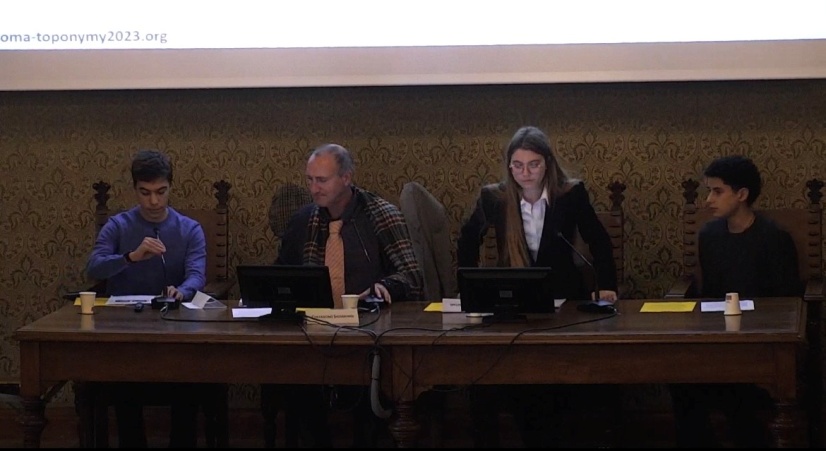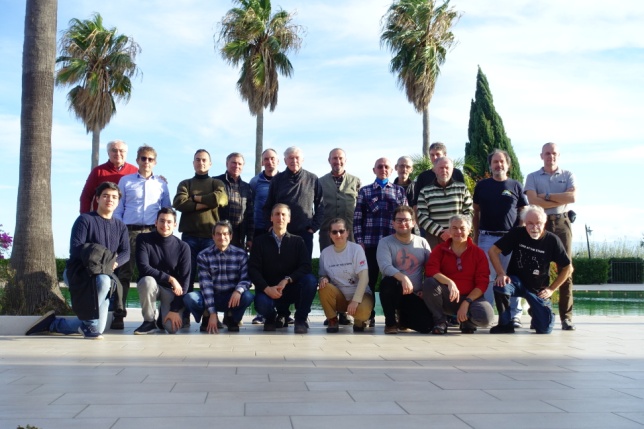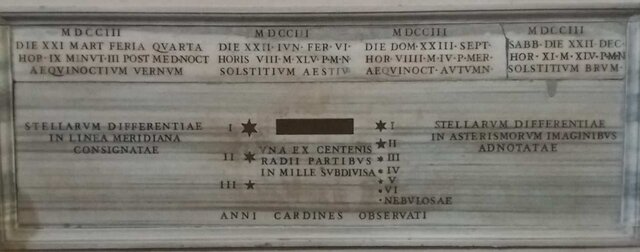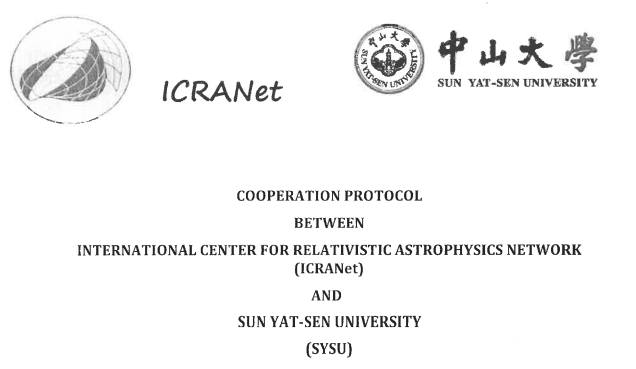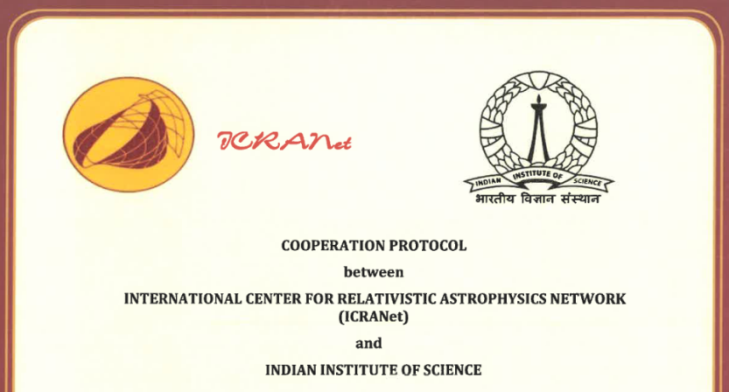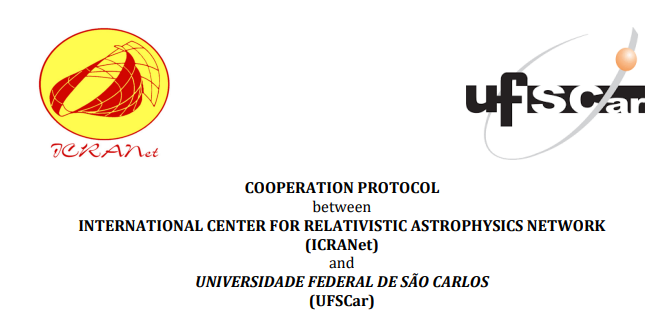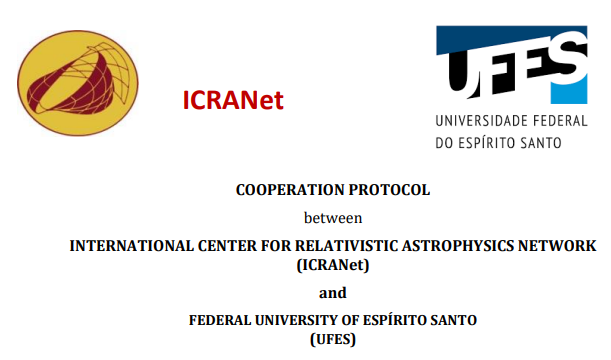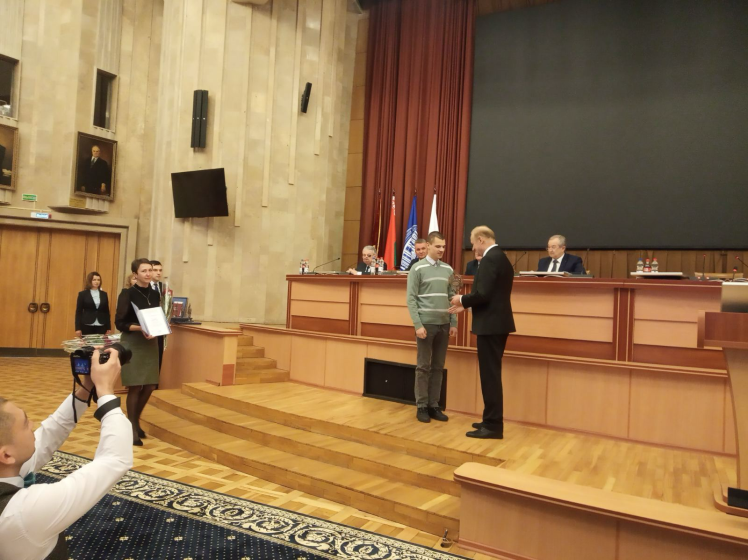

| Novembre-Dicembre 2023 - Gennaio 2024 |

|

|
   ICRANet Newsletter
ICRANet Newsletter
Novembre-Dicembre 2023 – Gennaio 2024
SUMMARY
1. Comunicato stampa ICRA – ICRANet – UNLP - INAF “Dark matter can solve the supermassive black-hole formation puzzle” 2. Partecipazione dell’ICRANet all’International Symposium on Cosmology and Particle Astrophysics (CosPA 2023), 10 – 13 Novembre 2023, Hong Kong ed online 3. Partecipazione dell’ICRANet all’inaugurazione dell’anno accademico 2023/2024 dell’Università G. d’Annunzio di Chieti-Pescara, 17 Gennaio 2024 4. L’occultazione di Venere da parte della luna, 9 Novembre 2023: osservazioni e presentazione presso l’Accademia dei Lincei (Roma) 5. Osservazione dell’occultazione di Betelgeuse, 12 Dicembre 2023, Sibari (Calabria, Italia) 6. Creazione della rivista scientifica “BALMER” presso l’Accademia dei Lincei a Roma, 24 Novembre 2023 7.Workshop IAU-NASE in memoria del Prof. Jay M. Pasachoff, 16 Dicembre 2023 8. Due conferenze sull’astrometria del solstizio d’inverno presso la Basilica di S. Maria degli Angeli a Roma, 21 e 22 Dicembre 2023 9. Rinnovo del protocollo di cooperazione tra l’ICRANet e la Sun Yat-Sen University (SYSU), 15 Novembre 2023 10. Nuovo protocollo di cooperazione tra l’ICRANet e l’Universidade Federal de São Carlos (UFSCar), 1 Dicembre 2023 11. Nuovo protocollo di cooperazione tra l’ICRANet e l’Indian Institute of Science (IIS), 7 Dicembre 2023 12.Nuovo protocollo di cooperazione tra l’ICRANet e l’Universidade Federal do Espírito Santo(UFES), 10 Gennaio 2024 13. L’articolo di Prakapenia e Vereshchagin è nella Top-10 list dell’Accademia nazionale delle Scienze di Bielorussia nel 2023 14. Seminario della Dott.ssa Meruert Takibayeva presso il centro ICRANet a Pescara, 15 Novembre 2023 15. Visite scientifiche presso l’ICRANet 16. Pubblicazioni recenti
1.IComunicato stampa ICRA – ICRANet – UNLP - INAF “Dark matter can solve the supermassive black-hole formation puzzle”
High-precision measurements of stellar
orbits in galaxies’ outskirts and central regions, together with theoretical progress combining particle
physics and general relativistic galaxy modeling carried out in the last decade at ICRANet, including the
explanation of the orbital motion of the closest stars around the Milky Way’s center, Sagittarius (Sgr) A*,
have revealed the possible nature of the dark matter particles to be fermions with a mass in the sub-MeV
range, likely about one-fifth of the electron’s mass. The question of how supermassive black holes (SMBHs) get
so massive so rapidlyin the early universe challenges the current standard cosmological model. Such tension is
increasing with the daily observations of the James Webb Space Telescope (JWST), whose exploration of our
universe in the dawn of stellar and galaxy formation at cosmological redshifts z ≈ 10–15, is unveiling a
population of SMBHs heavier than ten million times solar masses. No current model provides a clear explanation
of how such SMBHs have formed in a time as short as a hundred million years after the Big Bang. In a new
research to be published in The Astrophysical Journal Letters, scientists from ICRANet, La Plata National
University, and CONICET have shown that, once again, dark matter can rescue cosmology. This opens new synergy
research from cosmology, astrophysics, and terrestrial laboratories in the quest to identify such a light
sub-MeV particle. In this line, there are ongoing collaborations between ICRANet and the most intense
high-energy sources on planet Earth, the Deutsches Elektronen-Synchrotron (DESY), the European Hard X-ray Free
Electron Laser (EuXFEL), both in Hamburg, and the Extreme Light Infrastructure (ELI) in Prague.
In a previous article published early
in 2023 in the Monthly Notices of the Royal Astronomical Society journal, this research team had shown that
the gravitational collapse of dense cores of dark matter made of fermions would form SMBHs of tens to hundred
million solar masses if the fermion has a mass in the range of 50–100 keV, i.e., between one-tenth and
one-fifth of the electron’s mass. In that article, the authors showed that these SMBH seeds could comfortably
grow by accretion up to a billion solar masses in timescales of a hundred million years. Therefore, this
scenario could solve the SMBH formation problem in the high-z universe, providing one can answer the following
crucial questions: how does an initially stable dark matter core reach gravitational collapse conditions, how
long could that process take, and are those conditions realized in the required moment of the cosmological
evolution?
The authors answered these questions
using the fact that galaxy halos are not only made of dark matter but also ordinary (baryonic) matter. The
baryonic matter infall and sedimentation in the dark matter core could trigger its gravitational collapse for
a threshold amount of baryons that destabilizes the core since baryons provide mass but little pressure. The
publication shows, for example, that a dark matter core that has gained about 35% of its final budget in
baryonic matter collapses, forming SMBHs of about a hundred million solar masses. This amount of baryonic
matter could be gained in a hundred million-year timescale from a baryonic environment of one solar mass per
cubic centimeter of density and a hundred kilometers per second of velocity. See the Figure below for details.
These values are typically found in cosmological hydrodynamical simulations of high-z halos and observed in
the central regions of distant galaxies. The new publication focuses on the viability of the baryon-induced
collapse mechanism in three cases: the SMBH formation in the Seyfert galaxy TXS 2116–077 merging with a nearby
galaxy, the farthest quasar ever observed, located at z = 10.3 at the center of the JWST-galaxy UHZ1, and the
so-called little red dots, the population of JWST-SMBHs at z ≈ 4–6.
Interestingly, the required fermionic
cores playing the role of BH seeds are those of the dense core-diluted halo dark matter configurations
predicted by the Ruffini-Arguelles-Rueda (RAR) model. A series of previous publications have shown the
reliability of such a dark matter candidate as its core-halo dark matter galactic configurations explain a
variety of observables, including the galactic rotation curves, observational universal relations of galaxies,
and the2motion of the innermost stars near the Milky Way’s center, Sgr A*.
Therefore, SMBH formation, galactic
dynamics, and structure formation point to a non-interacting neutral, massive, spin 1/2 fermion with a rest
mass of ∼ 100 keV as the dark matter particle. Does this fermion fit any candidate proposed in particle
physics? A possibility is the right-handed sterile neutrino, but not only. Promising direct dark matter
searches in terrestrial laboratories via dark matter interactions with electrons and nucleons are already
looking for tens of keV fermion. This opens new synergy research from cosmology, astrophysics, and terrestrial
laboratories in the quest for such a light sub-MeV particle.
Contatti:
C. R. Arguelles, University of La
Plata Faculty and Ricercatore Conycet, carguelles@fcaglp.unlp.edu.ar
Jorge A. Rueda, Professore ICRANet, jorge.rueda@icra.it R. Ruffini, Direttore ICRANet, ruffini@icra.itruffini@icra.it
Articolo di riferimento:
Baryon-induced collapse of dark matter
cores into supermassive black holes
Autori: C.R. Arguelles, J.A. Rueda, R. Ruffini Da pubblicare in in The Astrophysical Journal Letters Preprint: https://arxiv.org/abs/2312.07461
Link al comunicato stampa sul sito dell’ICRANet: http://www.icranet.org/index.php?option=com_content&task=view&id=1032&Itemid=920
2.Partecipazione dell’ICRANet all’International Symposium on Cosmology and Particle Astrophysics (CosPA 2023), 10 – 13 Novembre 2023, Hong Kong ed online
Dal 10 al 13 Novembre 2023, il Prof. Ruffini, Direttore ICRANet, è stato invitato a presentare una plenary lecture in occasione dell’International Symposium on Cosmology and Particle Astrophysics 2023 (CosPA 2023), tenutosi presso la Chinese University of Hong Kong ed online.
The International Symposium on
Cosmology and Particle Astrophysics is a series of conferences organized in Asia Pacific region annually as an
activity of Asia Pacific Organization of Cosmology and Particle Astrophysics (APCosPA). COSPA 2023 has been
hosted by the Institute of Theoretical Physics, The Chinese University of Hong Kong, and sponsored by The
Croucher Foundation and Faculty of Science, The Chinese University of Hong Kong, and Asia Pacific Center for
Theoretical Physics.
Lo scopo della conferenza è stato quello di riunire teorici, sperimentatori e osservatori che lavorano nei campi della cosmologia, dell'astrofisica e della fisica delle astroparticelle, per discutere le ultime osservazioni, i risultati teorici e le prossime prospettive di progresso. Argomenti: Teorie classiche e quantistiche della gravità, cosmologia, radioastronomia, astronomia delle onde gravitazionali e astrofisica relativistica.
Il 10 Novembre, il Prof. Ruffini ha presentato una plenary lecture dal titolo “GRBs understanding leads to a new era in science and technology”; di seguito l’abstract:
Fifty years of daily conceptual and
theoretical progress, and the accomplishment of the largest ever multiwavelength - multi messenger
observational effort, have allowed to reach our understanding of GRBs and associated Supernovae. The results
expand the knowledge in physics and astrophysics.
GRBs have allowed:
Per il sito web del meeting:https://www.phy.cuhk.edu.hk/CosPA2023/#new_tab
3.Partecipazione dell’ICRANet all’inaugurazione dell’anno accademico 2023/2024 dell’Università G. d’Annunzio di Chieti-Pescara, 17 Gennaio 2024
Il 17 Gennaio 2024, il Prof. Ruffini è stato invitato dal Rettore, Prof. Liborio Stuppia, a partecipare alla cerimonia di inaugurazione dell’anno accademico 2023/2024 dell’Università degli studi G. d’Annunzio di Chieti-Pescara. La cerimonia si è svolta nell'Auditorium del Rettorato del Campus di Chieti ed ha visto, tra gli oratori, il Rettore Stuppia, il Prof. Pierluigi Sacco in rappresentanza dei Docenti, la Dott.ssa Anna Rita Tomei per il personale amministrativo e tecnico ed il Dott. Francesco Colangelo in rappresentanza degli studenti.
Alla cerimonia ha partecipato anche il Ministro dell'Università e della Ricerca italiano, S.E. Anna Maria Bernini, che ha insistito sul ruolo cruciale della ricerca nella nostra società.
Per maggiori informazioni sull’evento (notizie, foto, video e discorsi): https://www.unich.it/ateneo/l-uda/inaugurazione-anni-accademici/inaugurazione-anno-accademico-20232024
4.L’occultazione di Venere da parte della luna, 9 Novembre 2023: osservazioni e presentazione presso l’Accademia dei Lincei (Roma)
Il 9 Novembre 2023, in mattinata, il Prof. Costantino Sigismondi, ICRANet Adjunct Professor e collaboratore, ha osservato e presentato l’occultazione di Venere da parte della luna sia agli studenti del liceo che presso l’Accademia dei Lincei a Roma.
In questa occultazione, il Prof. Sigismondi è riuscito a correggere la longitudine eclittica della Luna con una precisione pari alle dimensioni di un campo da tennis. Le Effemeridi, combinate con il profilo Watts/Kaguya-SELENE del lembo lunare al momento dell'occultazione nel punto preciso dell'occultazione, vengono confrontate con l'osservazione. Questo viene fatto sia per l'entrata che per l'uscita, in modo da ridurre al minimo qualsiasi problema di sincronizzazione temporale assoluta.
Nella Fig. 2 viene presentata la ripresa video effettuata dagli studenti di fisica del Prof. Sigismondi presso il Liceo Galileo Ferraris di Roma (https://youtu.be/yxqykQwi2xA), con un telescopio Newton da 25 cm f/4 donato dalla Parrocchia di S. Maria Madre della Provvidenza. In quell'occasione, sono riusciti a individuare il fotogramma della scomparsa di Venere nel video ripreso a 30 fotogrammi al secondo, ottenendo una precisione di ± 0,015 s, che dà ± 15 m a 1 km al secondo della velocità orbitale della Luna. È la prima volta che si ottiene una misura di questo tipo con un'occultazione lunare di giorno e in una scuola.
Già nel 1996 il Prof. Sigismondi aveva organizzato un'occultazione planetaria di Giove presso l'Università La Sapienza di Roma, nel 2007 quella di Saturno insieme agli studenti dell'Istituto Nazareth di Roma, nonché nel 2009 quella di Venere presso l'Ateneo Pontificio Regina Apostolorum: tutte queste occultazioni si sono svolte di notte. Analoghi fenomeni diurni sono stati i transiti di Mercurio osservati nel 2003 all'ITIS Armellini di Roma, nel 2016 all'ICRA di Roma e quello dell'11 novembre 2019 al centro ICRANet di Pescara, insieme agli studenti del liceo Galileo Galilei di Pescara.
Venerdì 24 novembre, il Prof. Sigismondi ha presentato questi risultati, insieme ad altri argomenti, presso l'Accademia dei Lincei in occasione del convegno “Nomi di luoghi letterari, polari ed extraterrestri”, dove, per la prima volta, gli studenti delle scuole secondarie di secondo grado hanno presentato alcuni dei loro lavori insieme ad altri partecipanti internazionali al convegno, vedi Fig. 3.
Per il video della conferenza:https://www.lincei.it/it/videoteca/24112023-literary-polar-and-extraterrestrial-place-names-part-4
Questa attività è stata sviluppata nell'ambito del progetto “Alternanza Scuola Lavoro/PCTO”, che ICRANet porta avanti con le scuole superiori locali dal 2015.
5.Osservazione dell’occultazione di Betelgeuse, 12 Dicembre 2023, Sibari (Calabria, Italia)
Dall’11 al 13 Dicembre 2023, il Prof. Costantino Sigismondi, ICRANet Adjunct Professor e collaboratore, si è recato a Sibari (Calabria, Italia) per osservare l’occultazione di Betelgeuse che aiuterà a mappare la sua superficie.
L'occultazione asteroidale di Leona su Betelgeuse del 12 Dicembre 2023, ha offerto l'opportunità di studiare la disomogeneità della superficie della stella supergigante più vicina, combinando i dati di un “telescopio diffuso” dislocato sulla costa ionica calabrese. I luoghi per l'osservazione dell'occultazione asteroidale di Betelgeuse sono stati scelti sulla costa ionica della Calabria, per la vicinanza alla linea centrale e per il cielo più limpido, secondo le ultime previsioni meteo (meteoblue 16 ore prima dell'occultazione). È stata presentata una previsione della magnitudine raggiunta da Betelgeuse al massimo dell'occultazione, rispetto alla Limb Darkening Function e alla linea centrale prevista, con la corrispondente barra di errore di 10 milliardesimi di secondo.
Il 24 Novembre 2023 si è tenuto un incontro informativo di AstroCampania, con un'interessante presentazione di Alfonso Noschese (AstroCampania e IOTA/ES), autore delle migliori curve di luce. Noschese ha presentato l'idea della maschera di buchi, che ha poi realizzato e pubblicizzato con Claudio Costa (Specola Vaticana e IOTA/ES).
Il 9 Dicembre 2023, il Prof. Sigismondi ha pubblicato l’Astromer’s TelegramATel #16374: includendo Noschese e Costa, che hanno sperimentato la maschera sui loro grandi telescopi. Per il momento è stato l'articolo di ATel più letto.
All the videos realized by Prof.
Tutti i video realizzati dal Prof. Sigismondi durante il suo viaggio a Sibari sono stati raccolti al seguente link:: http://www.icranet.org/index.php?option=com_content&task=view&id=1515
Per quanto riguarda il miglioramento del rapporto segnale/rumore per le osservazioni dell'occultazione di Betelgeuse del 2023, il Prof. Sigismondi ha riferito che ricercatori francesi e spagnoli hanno preparato un nuovo apparato per un'analisi accurata con tutti i dati insieme: simulador de la Ocultacio'n de Betelguese por Leona (https://starblink.org/occult_simulator). La politica di IOTA è quella di produrre dati gratuiti. Il Prof. Sigismondi ha sottolineato come abbia contribuito a migliorare la qualità dei dati: teoricamente, sperimentalmente e, successivamente, sul campo. Per questo motivo, i suoi dati nuvolosi sono tra quelli di successo: mostrano il limite superiore del rapporto segnale/rumore a 12, mentre il grande telescopio da 50 cm ne ha forniti 30 in modo stabile. Un'ampia relazione su questo tema è stata preparata dal Prof. Sigismondi e può essere consultata al seguente link: http://icranet.org/documents/betelguese_occultation.pdf
Per maggiori informazioni su questa osservazione: http://www.icranet.org/index.php?option=com_content&task=view&id=1512=
6.Creazione della rivista scientifica “BALMER” presso l’Accademia dei Lincei a Roma, 24 Novembre 2023
La rivista scientifica “BALMER” è stata istituita presso l'Accademia dei Lincei di Roma (Galileo Galilei fu tra i primi borsisti). Il Prof. Costantino Sigismondi, ICRANet adjunct Professor e collaboratore, ha collaborato il 24 novembre 2023 alla creazione ufficiale di una nuova rivista accademica, peer reviewed, appositamente dedicata agli studi di astronomia posizionale e agli strumenti storici, presentata in occasione dell'intervento su invito che trattava dei passaggi del meridiano solare sul meridiano di Roma.
Il nome proposto è l'acronimo “BALMER” (Bollettino Astronomico delle Linee Meridiane e delle Effemeridi di Roma). Queste parole in inglese sono ordinate diversamente come segue: Astronomical Bulletin of the Meridian Lines and Ephemerides of Rome. Il nome è anche evocativo di Johann Jacob Balmer (1825-1898), un fisico svizzero noto a tutti gli astronomi per le linee spettroscopiche dell'idrogeno e per gli storici bollettini degli osservatori, come quello redatto dal Collegio Romano nei secoli XIX-XX.
La rivista sarà bilingue e il codice ISSN sarà 2038 - 3630.
Il primo numero è quello del 2023, con la presentazione della rivista e delle effemeridi dell'anno successivo.
7.Workshop IAU-NASE in memoria del Prof. Jay M. Pasachoff, 16 Dicembre 2023
Il Network for Astronomy School Education (IAU-NASE), ha organizzato un workshop speciale il 16 dicembre 2023, per celebrare la memoria del Prof. Jay M. Pasachoff, uno dei più famosi astronomi del pianeta, che ha partecipato a diversi meeting ICRANet dal 2019 al 2022, diventando un amico e un ospite speciale. Durante la sua ultima partecipazione, ha salutato il Prof. Ruffini in occasione del suo 80° compleanno.
Professore di astronomia al Williams College, Jay Pasachoff è stato un punto di riferimento internazionale per l'insegnamento della fisica solare e dell'astronomia. Il suo libro di testo è stato adottato in tutto il mondo. Nel corso della sua vita ha osservato 75 eclissi solari ed è stato in grado di riconoscere ognuna di esse dai dettagli della corona solare. Raccolse il testimone del Prof. Donald Menzel (1901-1976) che gli donò la sua cattedra ad Harvard. Ha ispirato e fatto riflettere un gran numero di studenti in tutto il mondo.
Uno dei progetti che sicuramente lo avrebbe entusiasmato è l'osservazione dell'occultazione di Betelgeuse da parte dell'asteroide 319 Leona il 12 dicembre 2023, pertanto questo workshop è stato un omaggio alla sua idea, all'osservazione, che è stata effettuata dai colleghi lungo il percorso dell'occultazione, nonché alla sua personalità, concentrandosi su diversi aspetti del suo lavoro e della sua vita, come raccontato da alcuni suoi stretti colleghi e familiari. A questo incontro hanno partecipato i più importanti fisici solari e scienziati che si occupano di meccanica celeste e stelle variabili.
Il Prof. Costantino Sigismondi, ICRANet Adjunct Professor e collaboratore, è stato invitato a partecipare a questo IAU meeting; ha fatto una presentazione sulle eclissi solari e stellari e sui diametri, presentando i risultati preliminari della campagna osservativa calabrese dell'occultazione di Betelgeuse del 12 Dicembre 2013.
Per il video YouTube del meeting:
https://www.youtube.com/watch?v=kC1vcdy8N_k&t=3697s
La presentazione del Prof. Sigismondi inizia al minuto 1:01:37
8.Due conferenze sull’astrometria del solstizio d’inverno presso la Basilica di S. Maria degli Angeli a Roma, 21 e 22 Dicembre 2023
Il Prof. Costantino Sigismondi, ICRANet Adjunct Professor e collaboratore, ha tenuto 2 conferenze sull’astrometria del solstizio d’inverno presso la Basilica di S. Maria degli Angeli a Roma, il 21 e 22 Dicembre 2023.
L'effetto delle condizioni meteorologiche è stato misurato nello stesso allineamento celeste (i giorni del solstizio lo consentono): il 21 Dicembre l'immagine del Sole era a 96 mm dall'estremità della linea meridiana, mentre il 22 Dicembre l'immagine era a 88 mm, con un supplemento di 3 mm dato dalla minore pressione atmosferica.
Il 22 Dicembre 1703 (misura riportata sul marmo, vedi foto) si trovava all'estremità della linea meridiana, a causa della maggiore inclinazione dell'asse terrestre.
Per il video della conferenza tenutasi il 21 Dicembre 2023: https://youtu.be/28kWxpZ7YXk
Per il video della conferenza tenutasi il 22 Dicembre 2023:https://youtu.be/jdAaMm3Mna4
9.Rinnovo del protocollo di cooperazione tra l’ICRANet e la Sun Yat-Sen University (SYSU), 15 Novembre 2023
Il 15 Novembre 2023, l’accordo di cooperazione tra l’ICRANet e la Sun Yat-Sen University (SYSU) è stato rinnovato. Il rinnovo è stato firmato dal Prof. Song Gao (Presidente della SYSU), dal Prof. Jianwei Mei (Professore TianQuin Center), dal Prof. Remo Ruffini (Direttore ICRANet) e dal Prof. Jorge Rueda (ICRANet Faculty Professor). Questo accordo sarà valido per 5 anni e le principali attività congiunte da sviluppare nell'ambito di esso comprendono: lo scambio istituzionale di studenti laureati, post-laurea, ricercatori e membri di facoltà, lo sviluppo di attività didattiche e/o di ricerca relative alle aree di competenza e interesse di entrambe le organizzazioni, l'organizzazione di simposi, seminari, conferenze e corsi brevi, la promozione e il sostegno di eventi e attività tecnico-scientifiche e culturali aperte al pubblico; lo sviluppo di opportunità per la formazione di docenti e ricercatori universitari, l'organizzazione di corsi e attività di formazione, nonché lo sviluppo di aree di ricerca interistituzionali associate a programmi di laurea locali; la promozione di pubblicazioni congiunte; l'implementazione di attività orientate al sociale attraverso l'estensione accademica; lo scambio di informazioni relative alle attività di insegnamento e ricerca in entrambe le istituzioni, nonché la richiesta di finanziamenti internazionali per promuovere progetti di ricerca congiunti o implementare programmi di scambio di mobilità.
Per il testo dell’accordo: http://www.icranet.org/index.php?option=com_content&task=view&id=1194
10.Nuovo protocollo di cooperazione tra l’ICRANet e l’Universidade Federal de São Carlos (UFSCar), 1 Dicembre 2023
Il 1 Dicembre 2023, l’ICRANet ha firmato un protocollo di cooperazione con l’Universidade Federal de São Carlos (UFSCar) in Brasile. Il protocollo di cooperazione è stato firmato dalla Prof.ssa Ana Beatriz De Oliveira (Rettrice UFSCar) e dal Prof. Remo Ruffini (Direttore ICRANet).
Questo accordo sarà valido per 5 anni e le principali attività congiunte da sviluppare nell'ambito di esso comprendono: lo scambio istituzionale di studenti laureati, post-laurea, ricercatori e membri di facoltà, lo sviluppo di attività didattiche e/o di ricerca relative alle aree di competenza e interesse di entrambe le organizzazioni, l'organizzazione di simposi, seminari, conferenze e corsi brevi, la promozione e il sostegno di eventi e attività tecnico-scientifiche e culturali aperte al pubblico; lo sviluppo di opportunità per la formazione di docenti e ricercatori universitari, l'organizzazione di corsi e attività di formazione, nonché lo sviluppo di aree di ricerca interistituzionali associate a programmi di laurea locali; la promozione di pubblicazioni congiunte; l'implementazione di attività orientate al sociale attraverso l'estensione accademica; lo scambio di informazioni relative alle attività di insegnamento e ricerca in entrambe le istituzioni, nonché la richiesta di finanziamenti internazionali per promuovere progetti di ricerca congiunti o implementare programmi di scambio di mobilità.
Per il testo dell’accordo:http://www.icranet.org/index.php?option=com_content&task=view&id=1517
11.Nuovo protocollo di cooperazione tra l’ICRANet e l’Indian Institute of Science (IIS), 7 Dicembre 2023
Il 7 Dicembre 2023 l’CRANet ha firmato un nuovo protocollo di cooperazione con l’Indian Institute of Science (IIS) in India. Il protocollo di cooperazione è stato firmato dal Capt. Sridhar Warrier (Retd.) – registrar IIS, dal Prof. Banibrata Mukhopadhyay (Dipartimento di fisica IIS), dal Prof. Remo Ruffini (Direttore ICRANet) e dal Prof. Jorge Rueda (ICRANet Faculty Professor).
Questo accordo sarà valido per 5 anni e le principali attività congiunte da sviluppare nell'ambito di esso comprendono: lo scambio istituzionale di studenti laureati, post-laurea, ricercatori e membri di facoltà, lo sviluppo di attività didattiche e/o di ricerca relative alle aree di competenza e interesse di entrambe le organizzazioni, l'organizzazione di simposi, seminari, conferenze e corsi brevi, la promozione e il sostegno di eventi e attività tecnico-scientifiche e culturali aperte al pubblico; lo sviluppo di opportunità per la formazione di docenti e ricercatori universitari, l'organizzazione di corsi e attività di formazione, nonché lo sviluppo di aree di ricerca interistituzionali associate a programmi di laurea locali; la promozione di pubblicazioni congiunte; l'implementazione di attività orientate al sociale attraverso l'estensione accademica; lo scambio di informazioni relative alle attività di insegnamento e ricerca in entrambe le istituzioni, nonché la richiesta di finanziamenti internazionali per promuovere progetti di ricerca congiunti o implementare programmi di scambio di mobilità.
Per il testo dell’accordo: http://www.icranet.org/index.php?option=com_content&task=view&id=1510
12.Nuovo protocollo di cooperazione tra l’ICRANet e l’Universidade Federal do Espírito Santo (UFES), 10 Gennaio 2024
Il 10 Gennaio 2024, l’ICRANet ha firmato un nuovo protocollo di cooperaqzione con l’Universidade Federal do Espírito Santo (UFES) in Brasile. Il protocollo di cooperazione è stato firmato dal Prof. Paulo Sergio de Paula Vargas (Rettore UFES), dal Prof. Yuri Luiz Reis Leite (Capo dell’ufficio internazionale UFES), dal Prof. Remo Ruffini (Direttore ICRANet) e dal Prof. Jorge Rueda (ICRANet Faculty Professor).
Questo accordo sarà valido per 5 anni e le principali attività congiunte da sviluppare nell'ambito di esso comprendono: lo scambio istituzionale di studenti laureati, post-laurea, ricercatori e membri di facoltà, lo sviluppo di attività didattiche e/o di ricerca relative alle aree di competenza e interesse di entrambe le organizzazioni, l'organizzazione di simposi, seminari, conferenze e corsi brevi, la promozione e il sostegno di eventi e attività tecnico-scientifiche e culturali aperte al pubblico; lo sviluppo di opportunità per la formazione di docenti e ricercatori universitari, l'organizzazione di corsi e attività di formazione, nonché lo sviluppo di aree di ricerca interistituzionali associate a programmi di laurea locali; la promozione di pubblicazioni congiunte; l'implementazione di attività orientate al sociale attraverso l'estensione accademica; lo scambio di informazioni relative alle attività di insegnamento e ricerca in entrambe le istituzioni, nonché la richiesta di finanziamenti internazionali per promuovere progetti di ricerca congiunti o implementare programmi di scambio di mobilità.
Per il testo dell’accordo:http://www.icranet.org/index.php?option=com_content&task=view&id=1521
13.L’articolo di Prakapenia e Vereshchagin è nella Top-10 list dell’Accademia nazionale delle Scienze di Bielorussia nel 2023
L’Ufficio del Presidium dell'Accademia Nazionale delle Scienze della Bielorussia ha riconosciuto, tra i 10 migliori risultati dell'attività degli scienziati dell'Accademia delle Scienze per il 2023, il lavoro del Dr. Mikalai Prakapenia (ICRANet-Minsk e Professore Aggiunto ICRANet) e del Prof. Gregory Vereshchagin (ICRANet) “Pauli blocking effects on pair creation in strong electric field”, pubblicato in Phyical Review D.
I 10 migliori risultati delle attività degli scienziati dell'Accademia Nazionale delle Scienze della Bielorussia nel campo della ricerca fondamentale e applicata si tiene annualmente, al fine di premiare i risultati più eccezionali nel campo della ricerca scientifica fondamentale e applicata.
Link per leggere l’articolo: https://journals.aps.org/prd/abstract/10.1103/PhysRevD.108.013002
14.Seminar of Dr Meruert Takibayeva
at ICRANet center in Pescara, November 15, 2023
Mercoledì 15 Novembre 2023, la Dott.ssa Meruert Takibayeva (al-Farabi Kazakh National University - Kazakhstan) ha presentato un seminario dal titolo “The role of nuclear resonances in the cooling of compact stars”. La Dott.ssa Takibayeva ha discusso di come le risonanze nucleari che si verificano durante le interazioni dei nucleoni possano influenzare le caratteristiche fisiche delle stelle di neutroni. Al seminario ha fatto seguito un'ampia discussione con gli scienziati di ICRANet.
L’annuncio del seminario è stato anche pubblicato sul sito web ICRANet: http://www.icranet.org/index.php?option=com_content&task=blogcategory&id=89&Itemid=781
15.Visite scientifiche presso l’ICRANet
Durante la loro visita, questi scienziati hanno avuto l'opportunità di discutere le loro ricerche scientifiche e di avere interessanti scambi con gli altri ricercatori dell'ICRANet e da diverse parti del mondo.
16.Pubblicazioni recenti
S. O. Komarov, A. K.
Gorbatsievich, and G. V. Vereshchagin, Electromagnetic field of a charge asymptotically approaching a
spherically symmetric black hole, published in Phys. Rev. D 108, 104056 on November 27, 2023.
We consider a test charged particle
falling onto a Schwarzschild black hole and evaluate its electromagnetic field. The Regge-Wheeler equation is
solved analytically by approximating the potential barrier with Dirac delta function and rectangular barrier.
We show that for asymptotically large times measured by a distant observer the electromagnetic field
approaches the spherically symmetric electrostatic field. This implies that in the region accessible to a
distant observer the initial state of separated charge and the electromagnetic field outside the event horizon
of Schwarzschild black hole becomes asymptotically indistinguishable from the Reisnner-Nordström solution. The
implications of this result for some astrophysical models of black holes accreting charged particles are
discussed.
Arguelles, C. R.; Rueda, J.
A.; Ruffini, R., Baryon-induced collapse of dark matter cores into supermassive black holes, published inThe
Astrophysical Journal Letters, 961:L10 (6pp), on January 20, 2024.
Non-linear structure formation for
fermionic dark matter particles leads to dark matter density profiles with a degenerate compact core
surrounded by a diluted halo. For a given fermion mass, the core has a critical mass that collapses into a
supermassive black hole (SMBH). Galactic dynamics constraints suggest a ∼100 keV/c2 fermion, which
leads to ∼107M⊙ critical core mass. Here, we show that baryonic (ordinary) matter
accretion drives an initially stable dark matter core to SMBH formation and determine the accreted mass
threshold that induces it. Baryonic gas density ρb and velocity vb inferred from cosmological
hydro-simulations and observations produce sub-Eddington accretion rates triggering the baryon-induced
collapse in less than a Gyr. This process produces active galactic nuclei in galaxy mergers and the
high-redshift Universe. For TXS 2116-077, merging with a nearby galaxy, the observed 3×107M⊙ SMBH,
for Qb=ρb/v3b=0.125M⊙/(100km/s pc)3, forms in ≈0.6 Gyr,
consistent with the 0.5-2 Gyr merger timescale and younger jet. For the farthest central SMBH detected by the
Chandra X-ray satellite in the z=10.3 UHZ1 galaxy observed by the James Webb Space Telescope JWST), the
mechanism leads to a 4×107M⊙SMBH in 87-187 Myr, starting the accretion at z=12-15. The
baryon-induced collapse can also explain the ≈107-108M⊙ SMBHs revealed by the
JWST at z≈4-6. After its formation, the SMBH can grow to a few 109M⊙ in timescales
shorter than a Gyr via sub-Eddington baryonic mass accretion.
ArXiv pre-print: https://arxiv.org/abs/2312.07461
Sousa, M. F.; Coelho, J. G.;
de Araujo, J. C. N.; Guidorzi, C.; Rueda, J. A., On the Optical Transients from Double White-dwarf Mergers,
published in The Astrophysical Journal, Volume 958, Issue 2, id.134, 7 pp. on November 20, 2023.
Double white dwarf (DWD) mergers are
relevant astrophysical sources expected to produce massive, highly magnetized white dwarfs (WDs), supernovae
(SNe) Ia, and neutron stars (NSs). Although they are expected to be numerous sources in the sky, their
detection has evaded the most advanced transient surveys. This article characterizes the optical transient
expected from DWD mergers in which the central remnant is a stable (sub-Chandrasekhar) WD. We show that the
expansion and cooling of the merger's dynamical ejecta lead to an optical emission peaking at 1–10 days
postmerger, with luminosities of 1040–1041 erg s−1. We present simulations of
the light curves, spectra, and the color evolution of the transient. We show that these properties, together
with the estimated rate of mergers, are consistent with the absence of detection, e.g., by the Zwicky
Transient Facility. More importantly, we show that the Legacy Survey of Space and Time of the Vera C. Rubin
Observatory will likely detect a few/several hundred per year, opening a new window to the physics of WDs,
NSs, and SNe Ia.
Punsly, B., The cylindrical
jet base of M 87 within 100 μas of the central engine, published in Astronomy & Astrophysics, Volume 679
on November 2023.
A recent article on high-resolution 86
GHz observations with the Global Millimeter VLBI Array, the phased Atacama Large Millimeter/submillimeter
Array, and the Greenland Telescope describes the detection of a limb-brightened cylindrical jet, 25 μas < z
< 100 μas, where z is the axial displacement from the supermassive black hole in the sky plane. It was
shown to be much wider and much more collimated than 2D simulations of electromagnetic (Blandford-Znajek) jets
from the event horizon predicted. This was an unanticipated discovery. The claimed detection of a jet
connected to the accretion flow provides a direct observational constraint on the geometry and physics of the
jet launching region for the first time in any black hole jetted system. This landmark detection warrants
further analysis. This Letter focuses on the most rudimentary properties, the shape and size of the source of
the detected jet emission, the determination of which is not trivial due to line-of-sight effects. Simple
thick-walled cylindrical shell models for the source were analyzed to constrain the thickness of the jet wall.
The analysis indicates a tubular jet source with a radius R ≈ 144 μas ≈ 38M and that the tubular jet walls
have a width W ≈ 36 μas ≈ 9.5M, where M is the geometrized mass of the black hole (a volume comparable to that
of the interior cavity). The observed cylindrical jet connects continuously to the highly limb-brightened jet
(previously described as a thick-walled tubular jet) that extends to z > 0.65 mas, and the two are likely
in fact the same outflow (i.e., from the same central engine).
L. Pacioselli, O. Panella, M.
Presilla& S.-S. Xue, Constraints on NJL four-fermion effective interactions from neutrinoless double
beta decay, published in Journal of High Energy Physics, Volume 2023, Issue 11 on November 9, 2023.
We study the contribution of a heavy
right-handed Majorana neutrino to neutrinoless double beta decay (0νββ) via four-fermion effective
interactions of Nambu-Jona-Lasinio (NJL) type. In this physical scenario, the sterile neutrino contributes to
the nuclear transition through gauge, contact, and mixed interactions. Using the lower limit on the half-life
of 0νββ from the KamLAND-Zen experiment, we then constrain the effective right-handed coupling between the
sterile neutrino and the W boson: G WR. Eventually, we show that the obtained bounds are compatible with those
found in the literature, which highlights the complementarity of this type of phenomenological study with
high-energy experiments.
MAGIC collaboration,
Performance of the joint LST-1 and MAGIC observations evaluated with Crab Nebula data, published in
Astronomy & Astrophysics, Volume 680 on December 2023.
Aims. Large-Sized Telescope 1 (LST-1),
the prototype for the Large-Sized Telescope at the upcoming Cherenkov Telescope Array Observatory, is
concluding its commissioning phase at the Observatoriodel Roque de los Muchachos on the island of La Palma.
The proximity of LST-1 to the two MAGIC (Major Atmospheric Gamma Imaging Cherenkov) telescopes makes it
possible to carry out observations of the same gamma-ray events with both systems.
Methods. We describe the joint
LST-1+MAGIC analysis pipeline and used simultaneous Crab Nebula observations and Monte Carlo simulations to
assess the performance of the three-telescope system. The addition of the LST-1 telescope allows for the
recovery of events in which one of the MAGIC images is too dim to survive analysis quality cuts.
Results. Thanks to the resulting
increase in the collection area and stronger background rejection, we found a significant improvement in
sensitivity, allowing for the detection of 30% weaker fluxes in the energy range between 200 GeV and 3 TeV.
The spectrum of the Crab Nebula, reconstructed in the energy range between ~60 GeV and ~10 TeV, is in
agreement with previous measurements.
BagheriTudeshki, A.; Bordbar,
G. H.; EslamPanah, B., Effect of massive graviton on dark energy star structure, published in Physics of the
Dark Universe, Volume 42 on December 2023.
The presence of massive gravitons in
the field of massive gravity is considered an important factor in investigating the structure of compact
objects. Hence, we are encouraged to study the dark energy star structure in the Vegh’s massive gravity. We
consider that the equation of state governing the inner spacetime of the star is the extended Chaplygin gas,
and then using this equation of state, we numerically solve the Tolman–Oppenheimer–Volkoff (TOV) equation in
massive gravity. In the following, assuming different values of free parameters defined in massive gravity, we
calculate the properties of dark energy stars such as radial pressure, transverse pressure, anisotropy
parameter, and other characteristics. Then, after obtaining the maximum mass and its corresponding radius, we
compute redshift and compactness. The obtained results show that for this model of dark energy star, the
maximum mass and its corresponding radius depend on the massive gravity’s free parameters and anisotropy
parameter. These results are consistent with the observational data and cover the lower mass gap. We also
demonstrate that all energy conditions are satisfied for this model, and in the presence of anisotropy, the
dark energy star is potentially unstable.
Ahmadvand, Moslem; Bian,
Ligong; Shakeri, Soroush, Heavy QCD axion model in light of pulsar timing arrays, published in Phys.
Recently, pulsar timing array
experiments reported the observation of a stochastic gravitational wave background in the nanohertz range
frequency band. We show that such a signal can be originated from a cosmological first-order phase transition
(PT) within a well-motivated heavy (visible) QCD axion model. Considering the Peccei-Quinn symmetry breaking
at the TeV scale in the scenario, we find a supercooled PT, in the parameter space of the model, prolonging
the PT with the reheating temperature at the GeV scale.
Sigismondi, C.; Costa, C.;
Noschese, A.; Guhl, K.; Bisconte, M., Signal-to Noise improvements for observations of 2023 Betelgeuse's
Occultation, published in the Journal for Occultation Astronomy, Vol. 14, No. 4 on January 2024.
The occultation of Betelgeuse by the
asteroid Leona was known since decades, and it has been prepared carefully. The local organizers of
AstroCampania association were ready to react in real time to the meteo conditions and move and accomodate
many observers from the Thyrrenian to the Ionian coast of Calabria, near the predicted centerline. A IOTA/ES
meeting happened at lunch time in Cassano all'Ionio.
MAGIC collaboration, MAGIC
detection of GRB 201216C at z = 1.1, published in Monthly Notices of the Royal Astronomical Society, Volume
527, Issue 3 on January 2024.
Gamma-ray bursts (GRBs) are explosive
transient events occurring at cosmological distances, releasing a large amount of energy as electromagnetic
radiation over several energy bands. We report the detection of the long GRB 201216C by the MAGIC telescopes.
The source is located at z = 1.1 and thus it is the farthest one detected at very high energies. The emission
above 70 GeV of GRB 201216C is modelled together with multiwavelength data within a synchrotron and
synchrotron self-Compton (SSC) scenario. We find that SSC can explain the broad-band data well from the
optical to the very-high-energy band. For the late-time radio data, a different component is needed to account
for the observed emission. Differently from previous GRBs detected in the very-high-energy range, the model
for GRB 201216C strongly favours a wind-like medium. The model parameters have values similar to those found
in past studies of the afterglows of GRBs detected up to GeV energies.
|
|||||||||||||||||||||||||||||
|
||






